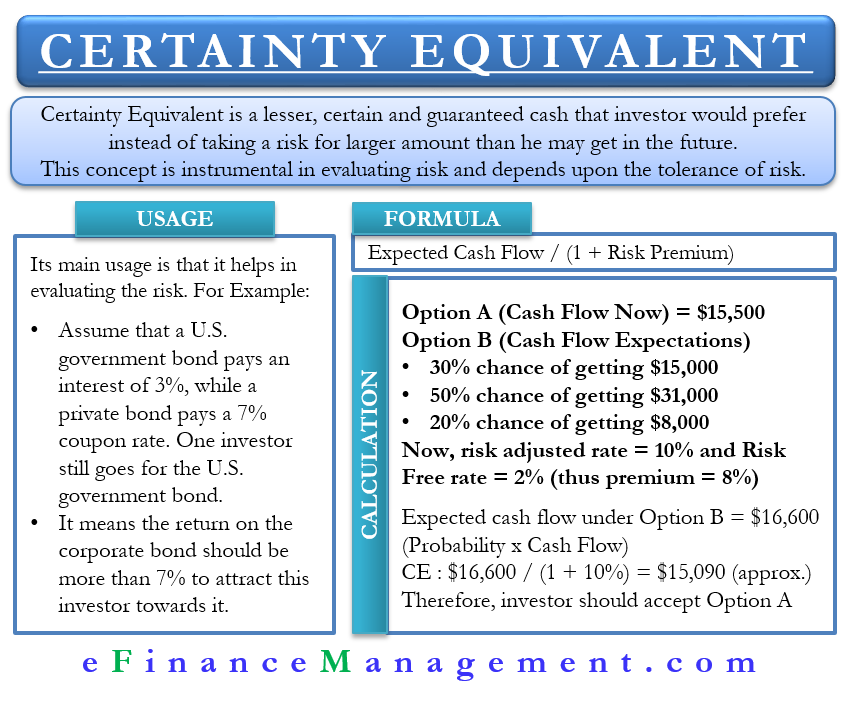Certainty Equivalent is the return or cash that an investor will accept today than the higher but uncertain return in the future. Or, we can say it is the certain or guaranteed cash that an investor would prefer instead of taking a risk for a larger amount that he may get in the future.
In simple words, we can say it is the lesser amount of money that one would accept to deny entering an event in which they may win an even larger amount of money. For example, a game involves drawing a card from a full deck of cards. If a person brings a red card, they win $50. In this case, the chances of winning or losing are equal. However, if the person accepts $20 to forgo picking the card, this $20 is the certainty equivalent. Here the person is at least assured of getting $20 though he may win $50 too. But there is an equal chance of getting nothing if he picks up the card.
This concept is instrumental in evaluating risk. A point to note is that the certainty equivalent depends on the risk tolerance of an individual, or we can say it may vary from individual to individual. For instance, a person nearing retirement would have a high certainty equivalent as they are less likely to put their retirement funds at risk.
Certainty Equivalent – How it’s Useful?
As said above, this concept helps in evaluating risk. Every investment must pay a return to the investors equivalent to the risk that they take. The higher the risk, the more the return that an investor expects.
Let’s take an example. Assume that a U.S. government bond pays an interest of 3%, while a private bond pays a 7% coupon rate. One investor still goes for the U.S. government bond. It means the return on the corporate bond should be more than 7% to attract this investor towards it.
A company that wants to attract investors to its bond can make use of such behavior. This company would now have an idea of how much return it needs to offer to encourage investors to take a riskier option.

Formula
The formula for certainty equivalent is in the term of cash flow from an investment. A certainty equivalent cash flow is the risk-free cash that one sees as equal to a larger but riskier expected cash flow.
Formula is – Expected Cash Flow / (1 + Risk Premium)
Here the Risk Premium is the risk-adjusted rate less than the risk-free rate. The risk-adjusted rate is the required rate of return on investment. We also use this rate to discount a company’s cash flow to its present value.
The Expected Cash Flow in the formula is the sum of the probability-weighted dollar value of each expected cash flow.
Example
Let us understand how to calculate certainty equivalent with the help of an example. Assume that an investor has a choice to accept (Option A) $15,500 cash flow now. Or, choose the other option (Option B) that has the following expectations:
A 30% probability of getting $15,000
A 50% probability of getting $21,000
A 20% probability of getting $8,000
The expected outflow in this case will be = (30%*$15,000) + (50%*$21,000) + (20%*$8,000)
= $4,500 + $10,500 + $1,600 = $16,600
Now assume the risk-adjusted rate to be 10% and the risk-free rate to be 2%. The risk premium will be 8% (10% Less than 2%).
Putting the values in the above formula, we get the equation = $16,600 / (1 + 8%) = $15,370 (approx.)
It means that to avoid taking a risk, an investor should accept any option that guarantees them $15,370 or more. So, in this case, an investor should accept Option A.
Certainty Equivalent in Gambling
The term Certainty Equivalent is not only useful in the field of finance but is also a common term in the field of gambling. In gambling, the term refers to the payoff that a player would need to be indifferent between the payoff and the gamble.
Continue reading – Advantages and Disadvantages of the Certainty Equivalent Method

